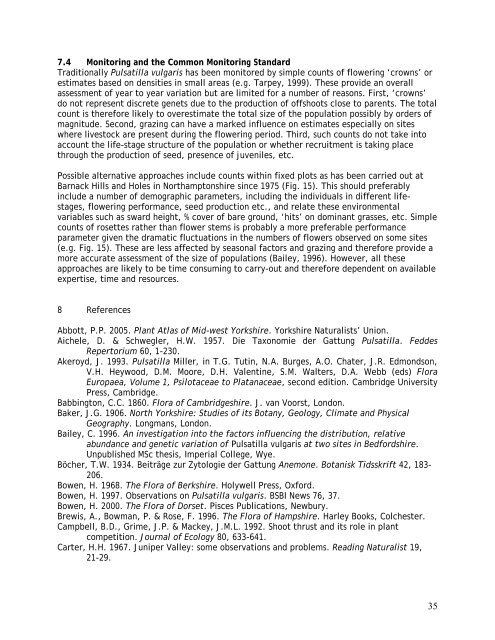Pulsatilla vulgaris (L.) Mill. - Plantlife
Pulsatilla vulgaris (L.) Mill. - Plantlife
Pulsatilla vulgaris (L.) Mill. - Plantlife
You also want an ePaper? Increase the reach of your titles
YUMPU automatically turns print PDFs into web optimized ePapers that Google loves.
7.4 Monitoring and the Common Monitoring Standard<br />
Traditionally <strong>Pulsatilla</strong> <strong>vulgaris</strong> has been monitored by simple counts of flowering ‘crowns’ or<br />
estimates based on densities in small areas (e.g. Tarpey, 1999). These provide an overall<br />
assessment of year to year variation but are limited for a number of reasons. First, ‘crowns’<br />
do not represent discrete genets due to the production of offshoots close to parents. The total<br />
count is therefore likely to overestimate the total size of the population possibly by orders of<br />
magnitude. Second, grazing can have a marked influence on estimates especially on sites<br />
where livestock are present during the flowering period. Third, such counts do not take into<br />
account the life-stage structure of the population or whether recruitment is taking place<br />
through the production of seed, presence of juveniles, etc.<br />
Possible alternative approaches include counts within fixed plots as has been carried out at<br />
Barnack Hills and Holes in Northamptonshire since 1975 (Fig. 15). This should preferably<br />
include a number of demographic parameters, including the individuals in different lifestages,<br />
flowering performance, seed production etc., and relate these environmental<br />
variables such as sward height, % cover of bare ground, ‘hits’ on dominant grasses, etc. Simple<br />
counts of rosettes rather than flower stems is probably a more preferable performance<br />
parameter given the dramatic fluctuations in the numbers of flowers observed on some sites<br />
(e.g. Fig. 15). These are less affected by seasonal factors and grazing and therefore provide a<br />
more accurate assessment of the size of populations (Bailey, 1996). However, all these<br />
approaches are likely to be time consuming to carry-out and therefore dependent on available<br />
expertise, time and resources.<br />
8 References<br />
Abbott, P.P. 2005. Plant Atlas of Mid-west Yorkshire. Yorkshire Naturalists’ Union.<br />
Aichele, D. & Schwegler, H.W. 1957. Die Taxonomie der Gattung <strong>Pulsatilla</strong>. Feddes<br />
Repertorium 60, 1-230.<br />
Akeroyd, J. 1993. <strong>Pulsatilla</strong> <strong>Mill</strong>er, in T.G. Tutin, N.A. Burges, A.O. Chater, J.R. Edmondson,<br />
V.H. Heywood, D.M. Moore, D.H. Valentine, S.M. Walters, D.A. Webb (eds) Flora<br />
Europaea, Volume 1, Psilotaceae to Platanaceae, second edition. Cambridge University<br />
Press, Cambridge.<br />
Babbington, C.C. 1860. Flora of Cambridgeshire. J. van Voorst, London.<br />
Baker, J.G. 1906. North Yorkshire: Studies of its Botany, Geology, Climate and Physical<br />
Geography. Longmans, London.<br />
Bailey, C. 1996. An investigation into the factors influencing the distribution, relative<br />
abundance and genetic variation of <strong>Pulsatilla</strong> <strong>vulgaris</strong> at two sites in Bedfordshire.<br />
Unpublished MSc thesis, Imperial College, Wye.<br />
Böcher, T.W. 1934. Beiträge zur Zytologie der Gattung Anemone. Botanisk Tidsskrift 42, 183-<br />
206.<br />
Bowen, H. 1968. The Flora of Berkshire. Holywell Press, Oxford.<br />
Bowen, H. 1997. Observations on <strong>Pulsatilla</strong> <strong>vulgaris</strong>. BSBI News 76, 37.<br />
Bowen, H. 2000. The Flora of Dorset. Pisces Publications, Newbury.<br />
Brewis, A., Bowman, P. & Rose, F. 1996. The Flora of Hampshire. Harley Books, Colchester.<br />
Campbell, B.D., Grime, J.P. & Mackey, J.M.L. 1992. Shoot thrust and its role in plant<br />
competition. Journal of Ecology 80, 633-641.<br />
Carter, H.H. 1967. Juniper Valley: some observations and problems. Reading Naturalist 19,<br />
21-29.<br />
35

















